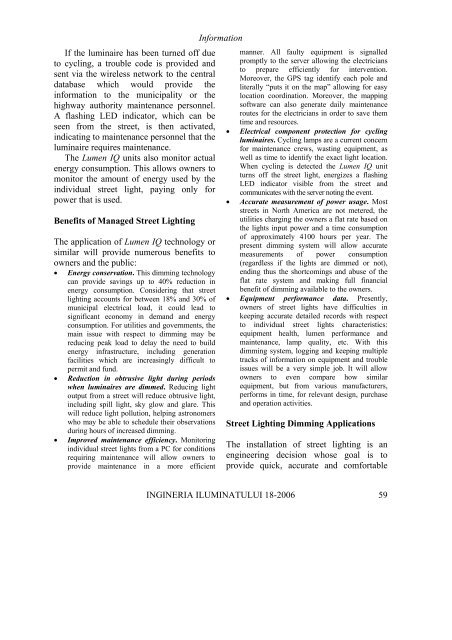This issue is sponsored by the Philips Romania, Lighting Division
This issue is sponsored by the Philips Romania, Lighting Division
This issue is sponsored by the Philips Romania, Lighting Division
Create successful ePaper yourself
Turn your PDF publications into a flip-book with our unique Google optimized e-Paper software.
If <strong>the</strong> luminaire has been turned off due<br />
to cycling, a trouble code <strong>is</strong> provided and<br />
sent via <strong>the</strong> wireless network to <strong>the</strong> central<br />
database which would provide <strong>the</strong><br />
information to <strong>the</strong> municipality or <strong>the</strong><br />
highway authority maintenance personnel.<br />
A flashing LED indicator, which can be<br />
seen from <strong>the</strong> street, <strong>is</strong> <strong>the</strong>n activated,<br />
indicating to maintenance personnel that <strong>the</strong><br />
luminaire requires maintenance.<br />
The Lumen IQ units also monitor actual<br />
energy consumption. <strong>Th<strong>is</strong></strong> allows owners to<br />
monitor <strong>the</strong> amount of energy used <strong>by</strong> <strong>the</strong><br />
individual street light, paying only for<br />
power that <strong>is</strong> used.<br />
Benefits of Managed Street <strong>Lighting</strong><br />
The application of Lumen IQ technology or<br />
similar will provide numerous benefits to<br />
owners and <strong>the</strong> public:<br />
• Energy conservation. <strong>Th<strong>is</strong></strong> dimming technology<br />
can provide savings up to 40% reduction in<br />
energy consumption. Considering that street<br />
lighting accounts for between 18% and 30% of<br />
municipal electrical load, it could lead to<br />
significant economy in demand and energy<br />
consumption. For utilities and governments, <strong>the</strong><br />
main <strong><strong>is</strong>sue</strong> with respect to dimming may be<br />
reducing peak load to delay <strong>the</strong> need to build<br />
energy infrastructure, including generation<br />
facilities which are increasingly difficult to<br />
permit and fund.<br />
• Reduction in obtrusive light during periods<br />
when luminaires are dimmed. Reducing light<br />
output from a street will reduce obtrusive light,<br />
including spill light, sky glow and glare. <strong>Th<strong>is</strong></strong><br />
will reduce light pollution, helping astronomers<br />
who may be able to schedule <strong>the</strong>ir observations<br />
during hours of increased dimming.<br />
• Improved maintenance efficiency. Monitoring<br />
individual street lights from a PC for conditions<br />
requiring maintenance will allow owners to<br />
provide maintenance in a more efficient<br />
Information<br />
manner. All faulty equipment <strong>is</strong> signalled<br />
promptly to <strong>the</strong> server allowing <strong>the</strong> electricians<br />
to prepare efficiently for intervention.<br />
Moreover, <strong>the</strong> GPS tag identify each pole and<br />
literally “puts it on <strong>the</strong> map” allowing for easy<br />
location coordination. Moreover, <strong>the</strong> mapping<br />
software can also generate daily maintenance<br />
routes for <strong>the</strong> electricians in order to save <strong>the</strong>m<br />
time and resources.<br />
• Electrical component protection for cycling<br />
luminaires. Cycling lamps are a current concern<br />
for maintenance crews, wasting equipment, as<br />
well as time to identify <strong>the</strong> exact light location.<br />
When cycling <strong>is</strong> detected <strong>the</strong> Lumen IQ unit<br />
turns off <strong>the</strong> street light, energizes a flashing<br />
LED indicator v<strong>is</strong>ible from <strong>the</strong> street and<br />
communicates with <strong>the</strong> server noting <strong>the</strong> event.<br />
• Accurate measurement of power usage. Most<br />
streets in North America are not metered, <strong>the</strong><br />
utilities charging <strong>the</strong> owners a flat rate based on<br />
<strong>the</strong> lights input power and a time consumption<br />
of approximately 4100 hours per year. The<br />
present dimming system will allow accurate<br />
measurements of power consumption<br />
(regardless if <strong>the</strong> lights are dimmed or not),<br />
ending thus <strong>the</strong> shortcomings and abuse of <strong>the</strong><br />
flat rate system and making full financial<br />
benefit of dimming available to <strong>the</strong> owners.<br />
• Equipment performance data. Presently,<br />
owners of street lights have difficulties in<br />
keeping accurate detailed records with respect<br />
to individual street lights character<strong>is</strong>tics:<br />
equipment health, lumen performance and<br />
maintenance, lamp quality, etc. With th<strong>is</strong><br />
dimming system, logging and keeping multiple<br />
tracks of information on equipment and trouble<br />
<strong><strong>is</strong>sue</strong>s will be a very simple job. It will allow<br />
owners to even compare how similar<br />
equipment, but from various manufacturers,<br />
performs in time, for relevant design, purchase<br />
and operation activities.<br />
Street <strong>Lighting</strong> Dimming Applications<br />
The installation of street lighting <strong>is</strong> an<br />
engineering dec<strong>is</strong>ion whose goal <strong>is</strong> to<br />
provide quick, accurate and comfortable<br />
INGINERIA ILUMINATULUI 18-2006 59
















